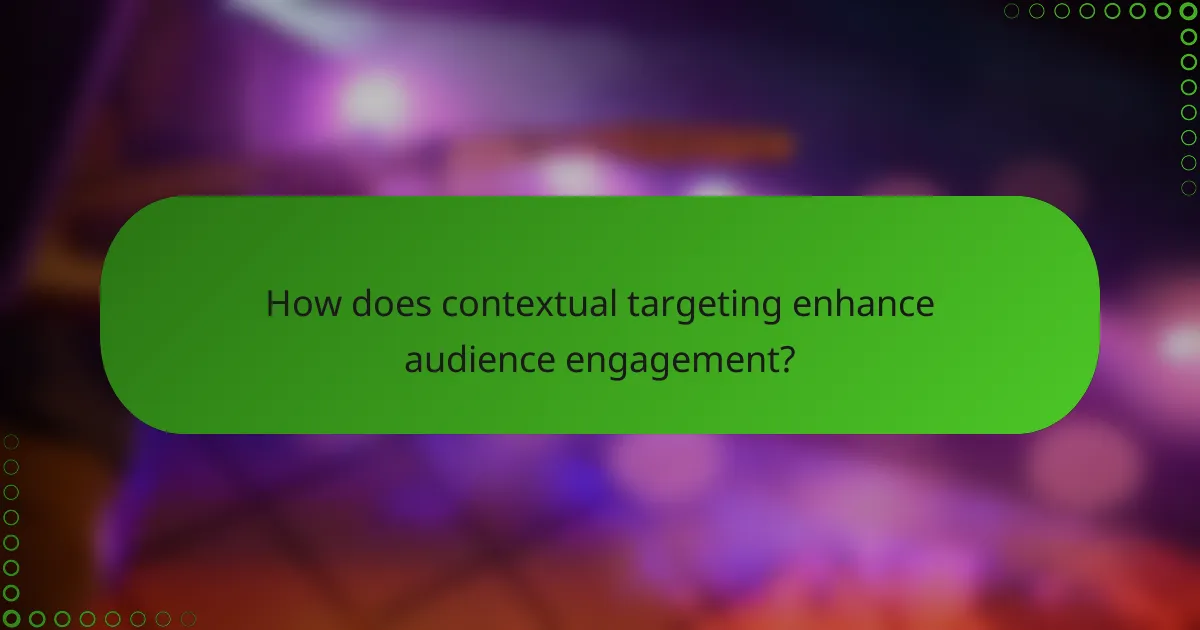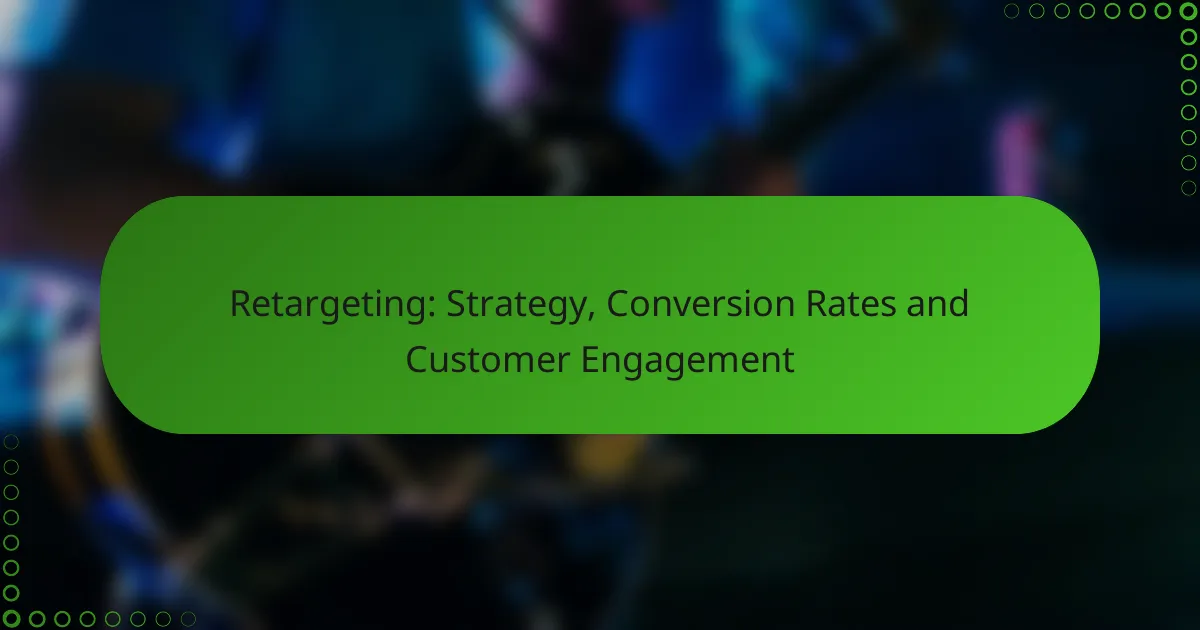Contextual targeting is a powerful advertising strategy that enhances audience engagement by delivering ads tailored to the content users are currently viewing. By focusing on relevance, timing, and audience segmentation, this approach ensures that advertisements resonate with users, increasing the likelihood of interaction and brand connection.

How does contextual targeting enhance audience engagement?
Contextual targeting enhances audience engagement by delivering ads that are relevant to the content users are currently viewing. This alignment increases the likelihood that users will find the ads interesting and engaging, leading to better overall interaction with the brand.
Improved relevance of ads
Contextual targeting ensures that ads are displayed alongside content that matches the interests of the audience. For instance, a user reading an article about fitness may see ads for workout gear or healthy meal plans. This relevance boosts the chances of the ad resonating with the viewer.
To maximize ad relevance, marketers should analyze the content themes and keywords that attract their target audience. Utilizing tools that assess content context can help refine ad placements, ensuring they align closely with user interests.
Increased click-through rates
Ads that are contextually relevant tend to have higher click-through rates (CTR) compared to generic ads. When users see ads that relate directly to their current interests, they are more likely to engage with them. Studies suggest that well-targeted ads can achieve CTRs that are significantly higher than industry averages.
To improve CTR, focus on creating compelling ad copy and visuals that complement the surrounding content. A/B testing different ad formats and placements can also help identify what resonates best with the audience.
Better user experience
Contextual targeting contributes to a better user experience by minimizing irrelevant ads that can frustrate users. When ads align with the content being consumed, users perceive them as part of their browsing experience rather than interruptions.
To enhance user experience, brands should avoid overly aggressive targeting that may lead to ad fatigue. Instead, maintaining a balance between frequency and relevance can keep the audience engaged without overwhelming them.

What are the key components of contextual targeting?
Contextual targeting relies on three main components: relevance to content, timing of ad delivery, and audience segmentation. Each element plays a crucial role in ensuring that advertisements resonate with users and enhance engagement.
Relevance to content
Relevance to content is about aligning ads with the surrounding material that users are engaging with. This means analyzing the context of web pages, articles, or videos to display ads that match the subject matter, thereby increasing the likelihood of user interaction.
For example, placing a travel ad on a blog post about vacation destinations is more effective than showing it on an unrelated site. Advertisers should utilize keyword analysis and content categorization to ensure their ads are contextually appropriate.
Timing of ad delivery
The timing of ad delivery is critical in maximizing the impact of contextual targeting. Ads should appear when users are most receptive, which often coincides with their engagement with relevant content. This requires real-time data analysis to determine optimal moments for ad placement.
For instance, displaying ads during peak browsing times or immediately after a user interacts with related content can significantly enhance visibility and click-through rates. Advertisers should monitor user behavior patterns to refine their timing strategies.
Audience segmentation
Audience segmentation involves dividing users into distinct groups based on demographics, interests, or behaviors to tailor ads more effectively. This allows for a more personalized advertising approach, increasing the chances of user engagement.
Advertisers should consider factors such as age, location, and browsing habits when segmenting audiences. For example, targeting younger audiences with trendy products on social media platforms can yield better results than a one-size-fits-all approach. Regularly updating audience profiles based on new data is essential for maintaining relevance.

What tools are available for contextual targeting?
Several tools facilitate contextual targeting by analyzing content and user behavior to deliver relevant ads. These platforms help advertisers reach their audience effectively by aligning ads with the context of the content being consumed.
Google Ads contextual targeting
Google Ads offers contextual targeting by allowing advertisers to display ads based on the content of the web pages users are visiting. Advertisers can select specific keywords or topics, and Google’s algorithms will match ads to relevant content, ensuring higher engagement rates.
When using Google Ads, consider the importance of selecting precise keywords that align with your target audience’s interests. Regularly reviewing performance metrics can help optimize your campaigns and improve ad relevance.
AdRoll platform
AdRoll provides contextual targeting by utilizing machine learning to analyze user behavior and content. This platform allows advertisers to create personalized ads that appear on websites relevant to their target audience, enhancing the likelihood of engagement.
To maximize effectiveness on AdRoll, focus on audience segmentation and retargeting strategies. Regularly updating your creative assets can also keep your ads fresh and appealing to users.
Taboola recommendations
Taboola specializes in content recommendations, using contextual targeting to suggest articles and ads based on user interests and the content they are currently viewing. This approach increases the chances of users clicking through to your content.
When leveraging Taboola, ensure your headlines and images are compelling to capture attention. Monitoring engagement metrics will help refine your strategy and improve the performance of your recommendations over time.

How can advertisers implement contextual targeting effectively?
Advertisers can implement contextual targeting effectively by aligning their ads with relevant content, ensuring they reach the right audience at the right time. This involves understanding the target audience, selecting appropriate keywords, and continuously analyzing content performance to optimize engagement.
Define target audience
Defining the target audience is crucial for effective contextual targeting. Advertisers should consider demographics, interests, and online behaviors to create a clear profile of their ideal customers. This understanding helps in tailoring messages that resonate with specific groups.
For instance, if targeting young professionals, advertisers might focus on platforms frequented by this demographic, such as LinkedIn or lifestyle blogs. Utilizing tools like Google Analytics can provide insights into audience characteristics and preferences.
Select relevant keywords
Selecting relevant keywords is essential for ensuring that ads appear alongside suitable content. Advertisers should conduct keyword research to identify terms that align with both their products and the interests of their target audience. Tools like Google Keyword Planner can assist in finding effective keywords.
It’s beneficial to use a mix of broad and specific keywords to capture various search intents. For example, a travel agency might use keywords like “affordable vacations” and “luxury beach resorts” to target different segments of travelers.
Analyze content performance
Analyzing content performance allows advertisers to refine their contextual targeting strategies. Regularly reviewing metrics such as click-through rates (CTR), conversion rates, and engagement levels helps identify which content resonates most with the audience.
Advertisers should implement A/B testing to compare the effectiveness of different ads and placements. This approach can reveal valuable insights, enabling advertisers to adjust their strategies based on what works best, ultimately enhancing audience engagement and return on investment.

What are the benefits of contextual targeting in display advertising?
Contextual targeting in display advertising offers several advantages, including improved relevance to the audience, increased engagement, and higher conversion rates. By aligning ads with the content users are currently viewing, advertisers can create a more personalized experience that resonates with potential customers.
Higher conversion rates
Contextual targeting can lead to higher conversion rates by ensuring that ads are displayed to users when they are most receptive. When an ad is relevant to the content being consumed, users are more likely to engage with it, leading to increased click-through rates and conversions.
For example, a user reading an article about fitness may respond positively to an ad for workout gear. This targeted approach can significantly enhance the likelihood of a purchase compared to generic ads.
Cost efficiency
Cost efficiency is another key benefit of contextual targeting. By focusing on relevant content, advertisers can reduce wasted ad spend on impressions that are unlikely to convert. This targeted approach often leads to a better return on investment (ROI).
Advertisers can optimize their budgets by selecting specific content categories or keywords that align with their target audience, ensuring that their ads reach the right people at the right time.
Enhanced brand safety
Contextual targeting enhances brand safety by allowing advertisers to control the environments in which their ads appear. By choosing specific content categories, brands can avoid placements next to inappropriate or controversial material.
This level of control helps maintain a positive brand image and ensures that advertising efforts are aligned with the values of the company, ultimately fostering trust with consumers.

What challenges do advertisers face with contextual targeting?
Advertisers encounter several challenges with contextual targeting, including data privacy regulations, the need for real-time data analysis, and ensuring relevance to diverse audiences. These obstacles can hinder the effectiveness of campaigns and limit the ability to engage users meaningfully.
Data privacy regulations
Data privacy regulations, such as the General Data Protection Regulation (GDPR) in Europe and the California Consumer Privacy Act (CCPA) in the United States, impose strict guidelines on how advertisers can collect and use consumer data. These laws require transparency and consent, making it challenging for advertisers to gather the necessary insights for effective contextual targeting.
Advertisers must navigate these regulations carefully to avoid hefty fines and reputational damage. This often means relying on aggregated data or contextual signals rather than personal information, which can limit the granularity of targeting efforts.
To comply with these regulations, advertisers should implement clear data policies, ensure user consent is obtained, and regularly review their data practices. Staying informed about changes in privacy laws is essential for maintaining effective targeting strategies while respecting consumer rights.









